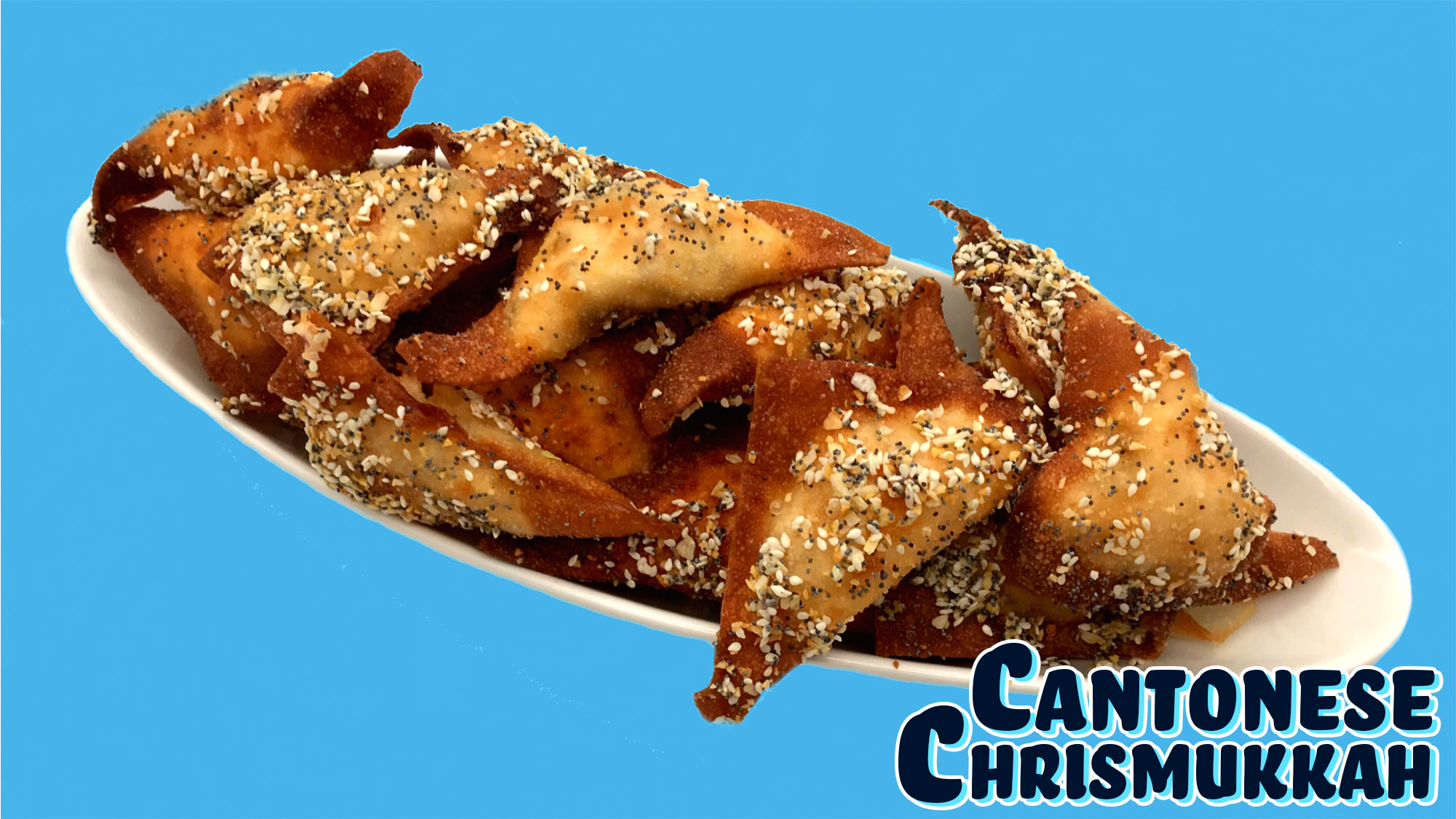Lox Rangoon Isn't Really Jewish Or Chinese, But It's Absolutely American
Christmas Day is a holiday on which many Jewish Americans enjoy a tradition of going to the movies and eating Chinese food. But this year, Christmas falls right in the middle of the eight days of Hanukkah, so we're presenting recipes that meld traditional Jewish dishes with American Chinese classics. We hope you enjoy this Cantonese Chrismukkah menu. It's not strictly kosher, but it does celebrate a particular Jewish-American family tradition. (You'll have to choose your own movie.)
It's hard to think of any Chinese restaurant menu without crab rangoon, just as it's hard to imagine a Jewish deli without lox. In our minds, both these dishes are so deeply ingrained in their cultures that it seems like they've always been there.
But it's my sad duty to inform you that this is not the case. Neither lox nor crab rangoon was ever consumed in the Old Country. It was only in America where they became part of their respective cuisines. Which makes it even more appropriate that they are united in Lox Rangoon, our third dish of Cantonese Chrismukkah.
Like just about everyone in northern Europe, the Jews of Russia, Poland, Ukraine, Latvia, and Lithuania ate smoked fish. But they didn't eat smoked salmon. This was because they had no salmon to smoke. The Russian tsars had consigned the Jews to live within specific geographic boundaries, an area called the Pale of Settlement that had no access to the ocean. The vast majority of them were also dirt poor since they were forbidden to own land or live in the major cities. These Jews ate mostly smoked whitefish and herring, Leah Koenig, the author of The Jewish Cookbook, told me. It was only when they came to America (specifically New York City), land of gold and opportunity and salmon, that they finally got to try lox, and it was true and everlasting love.
Crab rangoon, on the other hand, has absolutely no connection to China at all. It was invented sometime in the 1940s by Victor Bergeron, an American who had gotten caught up in the tiki craze that swept America after GI's returned from World War II with tales of the South Pacific. Bergeron owned a saloon in Oakland, California, that he called Trader Vic's, after himself. Originally Trader Vic's served American Chinese food, much of it devised by a Chinese-American barback named Joe Young. But Vic liked to mess around in the kitchen, too, his granddaughter Eve told Gastro Obscura's Dan Nosowitz, and one day he started playing with wonton wrappers and cream cheese, a staple of midcentury American cuisine, and voila! Crab rangoon!
Why was it named after a city in Burma (now called Yangon, Myanmar)? "It is simply a place in a general Southeast Asia-Polynesia-South Pacific zone," Nosowitz writes, "suitably exotic-sounding but still easy for native English speakers to pronounce." And how did it end up on Chinese restaurant menus? In the '40s and '50s, there was a great deal of overlap between tiki and American Chinese food. Both relied on sweet sauces and deep frying. It was natural for the two to borrow from each other and make certain substitutions, like fake crab for the real thing. (See also the pupu platter.)
For Lox Rangoon, Allison combines the classic bagel toppings—cream cheese, lox, capers, and red onion—and stuffs them all in a wonton wrapper, which is then deep-fried and coated with everything bagel seasoning. It's sweet, savory, and crispy—everything we love about crab rangoon and bagels and lox in one tidy wonton-wrapped package.

Lox Rangoon
Makes 32
- 3 Tbsp. capers
- 2 (8-oz.) packages of cream cheese
- 4 oz. smoked salmon, chopped
- 1/2 cup red onion, well minced
- 1/4 tsp. freshly cracked black pepper
- 32 wonton wrappers
- 1 egg
- 2 Tbsp. sesame seeds
- 2 Tbsp. poppy seeds
- 1 Tbsp. dried garlic flakes
- 1 Tbsp. dried onion flakes
- 2 tsp. coarse salt
- Oil for frying (I use vegetable, but canola, peanut, or shortening also work)
Line a plate with three paper towels, add the capers, and cover with another paper towel. Microwave for 90 seconds to dry out, then put into a large bowl with the cream cheese, salmon, red onion, and black pepper. Use a mixer or a heavy spoon to mix well.
Whisk the egg with a teaspoon of water to create an egg wash. Brush onto a dumpling wrapper, then add 1 Tbsp. of salmon filling into the center. Fold over to make a triangle, running your fingers around the edges to seal. Then use your thumbs to gently smoosh the filling so that it's evenly distributed throughout the wontons. Run your fingers around the edges a final time to make sure that they're sealed, then set aside to rest while you continue making wontons.
Fill a Dutch oven with at least 4" of oil. Clip on a frying thermometer and heat until about 375 degrees Fahrenheit. In a shallow bowl or pie pan, mix together the sesame seeds, poppy seeds, garlic flakes, onion flakes, and salt.
Fry the salmon rangoons on one side only until golden brown, about two minutes. Remove with tongs and dip into the seed mixture, then drain on a wire rack set over a paper towel-lined baking sheet. Serve immediately.
